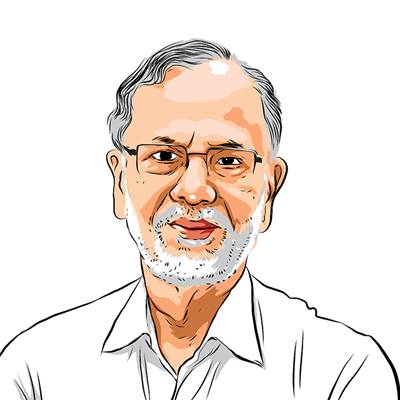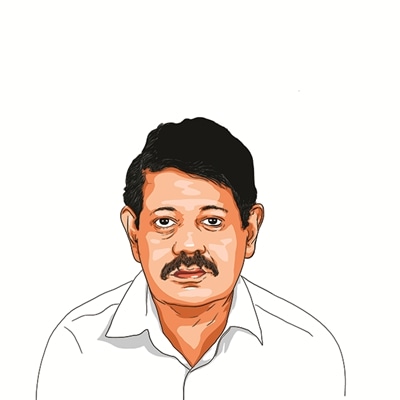Opinion It’s dangerous to take Omicron lightly
🔴 T. Jacob John, M S Seshadri write: The variant causes mild infections in young and healthy but can assume severe form in old and vulnerable.
 A young girl receives a dose of the Covid vaccine in New Delhi. (Express Photo: Amit Mehra)
A young girl receives a dose of the Covid vaccine in New Delhi. (Express Photo: Amit Mehra) The upsurge of Covid cases driven by the Omicron variant of the coronavirus has started in India, within a month of its first detection in Karnataka. For almost six months, from early July to the last week of December, India enjoyed a period of low daily cases, after the massive second wave caused by the Delta variant settled down to an endemic state. During most of November and December, the daily numbers were consistently below 10,000.
More than 13,000 cases were recorded on December 29 and by January 6, the daily case count had crossed 90,000. The number of tests conducted daily has remained stable, but the test-positivity rate has risen, confirming that the third wave of the pandemic has begun in the country. Kerala, Sikkim, and Arunachal Pradesh, the three states which witnessed a late onslaught of the Delta variant and late epidemic peaks, are exceptions to this trend.
The WHO declared Omicron a Variant of Concern (VOC) on November 26. The premier global health agency issued a timely alert to all countries to expect the next wave with massive numbers of infections. The only comforting news was that the disease numbers were a much smaller proportion of the infections — a watered-down version of Covid caused by the Delta variant. Fever, pneumonia and hypoxia are far less frequent than in the earlier waves. However, the elderly and those with immune-compromising ailments or therapies are at a high risk of severe disease and could need hospitalisation; they have a high risk of mortality.
We could face a rapid spread of infection and a disease wave of unpredictable proportions — it is likely to be less than the second wave but more than or equal to the first wave. Many in India tend to trivialise the new avatar of the virus as “the vaccine that scientists could not design” because of the mild form taken by the disease in the majority. That notion is dangerous because compared to the hospitalisation of vaccinated people for serious adverse reactions, the numbers who need intensive hospital care for severe disease will be much larger. For the young and healthy, the risk of severe disease with Omicron is indeed very low, but not zero. Inaction due to this misconception is unscientific and unethical.
We had no vaccine to flatten the first curve. We had vaccines three months before the onset of the second wave, but could not flatten the curve because there was insufficient vaccine stock and an ineffective distribution plan. Many of us lost loved ones and our economy suffered. The low and middle-income families faced — many continue to face — severe financial stress. But when the WHO alerted us about Omicron and the case count began to rise in European countries, we had a unique opportunity to attempt to minimise the disease burden and even mitigate the onslaught of infections.
We are at a loss to understand why policymakers waited for a month before making decisions that are disappointingly far too little to reduce the need for hospitalisations or slow the spread of infection. We had the choice of rapidly building up boosted immunity, both hybrid (prior infection plus vaccination) and vaccine-induced, by quickly initiating a massive booster vaccination campaign. For reasons unknown, the political will was lacking.
 Two properties of Omicron prompted the WHO to declare it a Variant of Concern within two days of notification by South African scientists: Extremely high transmission efficiency, far more than that of Delta, and the propensity to evade immunity induced by past infections and vaccinations. These properties are conferred by a large number of mutations on its spike protein gene. While Delta has two mutations on the receptor-binding domain of the spike protein, Omicron has 15. This has resulted in evasion from antibody binding, necessary for protection. Neutralising antibodies against the spike protein of the original virus, induced by all available vaccines (mRNA or adenovirus-vectored) are relatively ineffective against Omicron. However, recent experience shows that very high levels of antibodies that result from booster doses offer protection, especially from severe disease needing hospitalisation. This opportunity, our only hope to mitigate the otherwise risk-ridden disease wave, was squandered.
Two properties of Omicron prompted the WHO to declare it a Variant of Concern within two days of notification by South African scientists: Extremely high transmission efficiency, far more than that of Delta, and the propensity to evade immunity induced by past infections and vaccinations. These properties are conferred by a large number of mutations on its spike protein gene. While Delta has two mutations on the receptor-binding domain of the spike protein, Omicron has 15. This has resulted in evasion from antibody binding, necessary for protection. Neutralising antibodies against the spike protein of the original virus, induced by all available vaccines (mRNA or adenovirus-vectored) are relatively ineffective against Omicron. However, recent experience shows that very high levels of antibodies that result from booster doses offer protection, especially from severe disease needing hospitalisation. This opportunity, our only hope to mitigate the otherwise risk-ridden disease wave, was squandered.
The UK’s experience strongly supports booster doses. Vaccine effectiveness with any of the shots in current use in the UK — real-world, real-time protection against Covid caused by Omicron, requiring hospitalisation — was 72 per cent during two to 24 weeks after the second dose, but only 52 per cent after 25. But this shot up to 88 per cent two weeks after a booster dose. By the time such data becomes available in India, the wave would have naturally receded in the country.
Vaccination of children was the other part of mounting a wall of immunity against Omicron. The new policy offers vaccination for only a small proportion of the large segment of our population under 18. It is now too late to pursue this line because the Omicron wave may peak within weeks and building immunity with vaccines will take six weeks from the time the first dose is administered.
Everyone must strictly adopt personal prevention measures, double masks, hand hygiene, and good ventilation indoors and avoid crowds and non-essential travel.
This column first appeared in the print edition on January 7, 2022 under the title ‘Taming the third wave’. John retired as Professor of Clinical Virology, CMC, Vellore and Seshadri retired as Professor of medical endocrinology, CMC, Vellore







